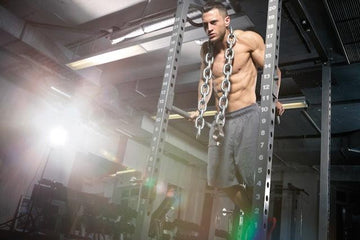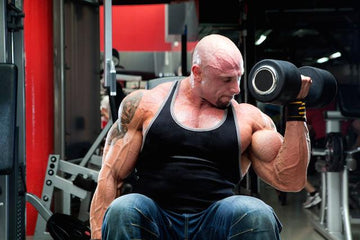

TRX Training: The Hardest Workout Your Not Doing
Table of Contents
TRX Training: The Hardest Workout Your Not Doing
Reprinted from MuscleMedia Online
In health clubs and gyms all over the country you’re certain to see people lifting weights, running on treadmills, pedaling on bikes, performing moves in synchronized fashion in aerobics class, and bending their limbs in strange positions trying to increase their flexibility. In recent years, there has been a new trend that has become one of the newest ways to get in shape and it doesn’t appear to be going away anytime soon. Professional athletes, hardcore fitness enthusiasts, and even beginners can all use this program that involves using these strange straps hanging from ceilings to get in better shape. If you’re not sure what I’m talking about, it’s called TRX and once you try it, you’ll probably be hooked like thousands of other people who now use it in their regular routines all the time.
What is TRX?

The letters TRX actually don’t have a definitive meaning but the most popular translation for the acronym is “Total Body Resistance Exercise”. As for what TRX actually is, it’s a form of suspension training designed to increase functional strength, flexibility, balance, and stability. The initial concept of suspension training was created by Randy Hetrick, a Navy SEAL and founder of TRX, and other members of his SEALS team looking for options to stay in peak physical condition when traditional fitness equipment wasn’t available.
The training revolves around a collection of various bodyweight movements that are different than old school exercises because either the trainer’s hand or feet are on the ground while the other limbs are braced to or holding a single anchor point. The result is a specific amount of bodyweight percentage is being loaded onto the isolated muscle group being focused on.
How to Incorporate Suspension Training
As mentioned before, regardless of your fitness levels, you can use TRX to help you reach your goals. TRX can be implemented in a variety of ways.
Athletes Improving Weaknesses – If you’re a basketball player and are focusing on one leg because it’s weaker than another, you can use this type of training to isolate that area to help it improve. You can also use it to help learn to control your bodyweight regardless of the sport you play.
Strength/Muscle Gains – Whether you’re trying to get stronger or trying to create hypertrophy, suspension training can allow you to focus on assistant exercises to help you gain strength or isolate a specific muscle group that you find to be a flaw in your physique.
Rehabilitation – Suspension training has been found to be a great strategy for therapy to help athletes come back from injuries since your bodyweight is the resistance and the strap offers assistance and support throughout the movements.
Cardiovascular – The different movements that can be used also can be combined into a circuit for a personal cardio workout or an intense aerobics class that can cater to all levels and ages.
Benefits of TRX Training

With one end of the strap anchored and your body holding the handles, you have a mix of mobility and support to train for strength, coordination, function, flexibility, balance, or power. All of these aspects are being targeted simultaneously so you get more training in less time. Another major benefit of suspension training is it is suited for all fitness levels. Whether you’re an elite athlete using the training to maximize your ability to perform or a beginner starting any fitness program for the first time, suspension training can help you. It also eliminates the excuse of not having enough time to go to the gym because the strap can be taken anywhere and used from any high point that the strap can be attached to and support your body weight. Also, since your body will be in different positions throughout the training, your center of gravity is changing frequently so your core is having to work at all times. Whether you’re training upper body or lower body, you’re also stimulating your core.
Keys to Suspension Training

As opposed to a machine where the exercise involves pulling an object in one specific motion, suspension training allows you a wide variety of movements and planes so you train like you move. Furthermore, whereas free weights are a loose object that is only controlled by your body, you have control of the strap with suspension training and your body weight is the resistance so you’ll be less likely to be injured. The TRX straps are adjustable to your height so regardless if you’re a seven foot plus NBA Center or a sub 5 foot gymnast, anyone can use the TRX straps according to their own physique. You can use your hands to hold the strap or brace your feet in them so the handles act as cuffs. Plus, you can change the length of the strap so you can use more or less of your body weight for different exercises. When you’re hanging from the straps or resting your body weight on them, gravity naturally tries to pull you toward the floor. Your response and resistance to this action will target the nervous system, require the muscular system to work harder, and maximize all the benefits of bodyweight training that you may not get with bodyweight exercises on their own. The benefits not only apply to athletes but people who work tough jobs that require strength and balance in awkward positions. One example is Mark Bowe, one of the stars of “Barnwood Builders” on DIY Network. He and his crew take down old barns, make improvements to the wood, and rebuild them into homes and buildings at new locations. He feels that the suspension training is better for him than traditional free weights and machines. “For me, TRX is great because I can apply my strength from the suspension training when I’m up 20 feet on a roof of an unstable building and feel confident that I can do what I need to do. I’m not trying to get stronger like a weightlifter would. I’m trying to make my strength last longer so I can finish the job I’m on. I can do that with TRX.”
Sample TRX Workout
This workout is designed for someone who has never tried TRX before. You will perform each exercise for 60 seconds before taking a one minute break. Repeat this pattern three times for a great cardio/suspension training workout. Try to work with a trainer if possible to help you feel comfortable with the positions before performing each exercise.
Upper Body Exercises
Chest Press – The handles of the straps should be at waist height. Hold a strap in each hand and take a step forward. Lean your body about 40-45 degrees forward. Keep your entire body in a straight line and keep your arms straight as well. Bend your elbows and lower your bodyweight until your chest is even with the strap handles. Push yourself back up until your arms are just short of locking out. This is one rep. Repeat for as many reps as you can.
Two Arm Mid Row – Shorten the straps as much as you can and stand facing the anchor point. While maintaining your body in a straight line and holding a handle of the strap in each hand, let yourself go back to a 45 degree angle so your arms are straightened and the strap is holding you up. Bend at the elbows and pull your body in so the straps are at your sides. Slowly return yourself to the starting position. This is one rep. Repeat for as many reps as you can.
Lower Body Exercises
Squat – Your straps should be mid-length. Stand facing the anchor point while holding the straps at arms’ length and have the straps at full length. Slowly lower yourself down into a squat position while holding on to the straps. Once your thighs are parallel with the floor, return to the standing position while maintaining the tension on the strap. Don’t lock out your knees once you’re standing. This is one rep. Repeat for as many reps as you can.
Hamstring Curl – The straps should be a calf height. Lie on your back and place your hips in the stirrups. Straighten your legs and raise your hips off the ground. Use your arms to support you. Bend your knees and bring your heels into your butt. Return to the starting position. That is one rep. Repeat for as many reps as you can.
Core Exercises
Plank – The handles should be about six inches off the ground. Place your feet in the stirrups so your toes are pointed to the floor. Get on your forearms and straighten your body so you’re parallel with the floor. Hold this position for the time required.
Bent Leg Raise – You will start in the plank position you were in during the last exercise. Shift from your forearms to your hands being on the floor so you’re in a push up position. Bring both knees in at the same time until they are past your hips. Focus on squeezing your abs while doing this. Slowly return to the starting position. This is one rep. Repeat for as many reps as you can.
Conclusion
If you’ve never tried suspension training before, consider trying TRX out for yourself and look for ways to make the workouts your own to help you reach your own goals. Many gyms and health clubs have certified TRX Trainers that can help you learn how to perform the movements and the best ways to add them into your own plan. There are several options that allow you to reap the benefits that the exercises offer. For more information on suspension training and TRX, go to www.trxtraining.com.[
MUSCLE MEDIA MAGAZINE FOR MEN
The premier source of training, nutrition, supplements, fat loss and health for men.

















